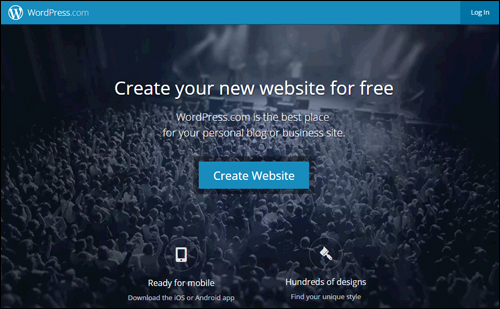
Welcome to Part Three of our Web Traffic Blueprint article series, where we show you how to create an automated traffic machine using the WordPress CMS.
In Part One of this series, we explained why using an expertly configured WordPress site is the key to generating automated traffic …

(With an expertly configured WordPress website, all you have to do is post great content on a regular basis to attract more traffic!)
In Part Two, we discussed critical setup decisions. We helped you understand the best way to get started if you don’t have a web presence yet, how to set things up if you already have a site, and what to do if your existing site was built with WordPress.

(In Part 2 we show you where to set up a WordPress website on your domain)
In this section of the series, we will look at the configuration phase of this process. We will show you why an expertly configured site is different, and how much work needs to be done to make sure that when all is set up and fully configured, traffic will automatically start flowing when you post fresh content on your web site.
WordPress Web Traffic Blueprint – Configuration Phase
The ability to drive more traffic to one’s website is often cited by website owners as their greatest challenge online. With business getting so much more competitive worldwide, it’s worth looking into every advantage that can help you get better results online.
Being able to generate traffic on demand can be a tremendous advantage over other competitors. For business owners, an expertly configured website gives WordPress users a flying start from the moment their site is launched.
The Difference Is In The Way Your Site Is Configured
There is a significant difference between an expertly configured WordPress site and a site that has been professionally set up by a website-building expert but not necessarily configured to take advantage of everything WordPress can offer you.
Here’s one way to describe the key difference:
With a WordPress site that has been expertly configured you get a professional web presence with an automated online business marketing system!

(An expertly configured site gives you a professional web presence with a built-in automated online business marketing system!)
Not only does it take more work to build and integrate an automated online business marketing process into your website, but also a special kind of expert knowledge.
Let me illustrate this with a little story.
Ludicrous Or Fair? You Decide …
All was going fine in the gizmo-making plant when suddenly, everything just stopped.
As no one could figure out what happened, the floor manager decided to call in an expert.
Shortly after arriving, the expert walked immediately towards the main control box. After staring at the board for no more than 2 minutes or so, the expert then took out a teeny-weeny hammer and made a very gentle tap near the left side of the unit.
Immediately, everything began working again.
The manager was greatly relieved as he thanked the expert, who left as quickly as he had arrived.
A few days after resolving the incident, the factory manager received a bill for $5,000.
The manager dialled the expert, demanding to know why they had been charged so much for so little time delivering such minimal amount of work. He then requested an itemized invoice before hanging up.
The next day, a bill of payment arrived and was placed on the manager’s desk. Upon opening the envelope, this is what he saw:
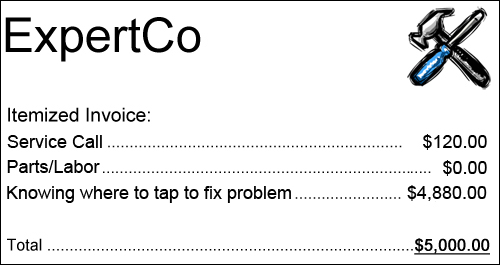
The number one challenge most businesses face online is being able to drive new visitors to their sites.
In the story we’ve just described, how much money did the widget plant stand to lose when the equipment ground to a halt and no one on the factory floor had the expertise to fix it? Did the expert not have the right to ask to be compensated fairly for spending years building up the knowledge, skills and expertise that allowed him to avert a serious crisis?
Similarly, if you could have your WP web site set up so all you had to do is publish content to it and search engines, social networks and dozens of other web properties would be immediately notified, how much time and money would this save you?

(How much better would your business be if you could automate the process of driving traffic to your site?)
While the solution to many challenges often seems quite easy once implemented, it rarely is that simple or easy.
Knowing how to expertly configure a WordPress site is more than just installing a website and configuring basic settings. It also requires knowing where to tap! This includes knowing things like:
- Which plugins need to be installed to get certain functionalities on your site.
- Which 3rd-party accounts you need to set up and activate to achieve certain results
- Which settings you need to configure in order to ensure that processes will run as envisioned, etc.

(Driving new traffic automatically with WordPress is a process that requires knowledge and expertise)
This stage of the WordPress traffic automation system is not technically challenging, but it’s quite involved. This is because it’s not as simple as installing and configuring one or two plugins, clicking on a button or two, or configuring some options and settings in your admin area … it’s all this and much more.
Expertly configuring your website is a process that involves your web server, your website, and various third-party sites and services …

(The configuration phase involves more than just configuring some settings in WordPress)
If we try to flowchart the steps involved in the configuration process, it would look something like this …

(A simplistic flowchart showing the activities involved in the configuration phase)
Let’s examine these areas in more detail.
Your Server
We’re not talking about the process of configuring your web-hosting account for site installation purposes. We’re talking about tweaking settings in your hosting account that affect how your website will handle web traffic …
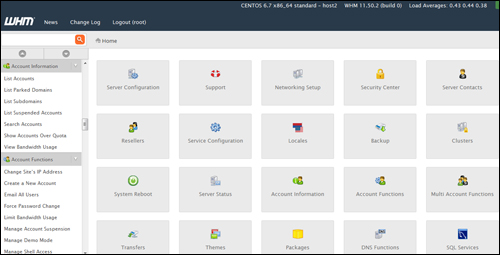
(In the configuration phase, your web server settings need to be fine-tuned for handling both good and bad traffic)
Not all traffic is beneficial traffic. Some of the traffic your website will attract will be unwanted traffic like spam, security threats, bot-hacking attempts, etc.
This area of the configuration process, therefore, requires planning for both good and bad traffic and adjusting settings in your server accordingly. This includes looking at things like spam protection and securing server files, to configuring domain and email forwarding, setting up 404 error page redirections, etc …
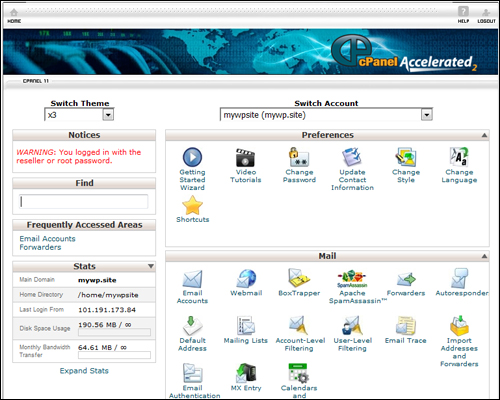
(Have you configured your hosting control panel settings for handling things like email forwarding, page errors, etc?)
Once your web server settings have been fine-tuned and configured, the next step is to configure a number of third-party sites.
External Accounts
The purpose of adding external sites is that all content will get posted to one central location (your site) and from there, it will be distributed automatically to other components of your web traffic system, or notify traffic-related web properties and applications.
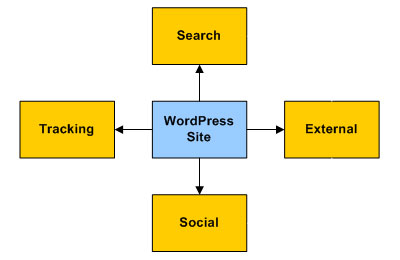
After incorporating these external services into your network, content linked back to your site is automatically added to these platforms. Your content and business benefits from added exposure online, helping your business tap into new audiences and new sources of traffic.

Some third-party web properties and online solutions will need to be set up before configuring your site’s settings to help save time and some will need to be done later, during the automation phase.
For example, you will want to set up the following accounts:
Google Webmaster Tools

(Google Search Console – create a Google-friendly website or blog)
Google Search Console lets you inform Google about your site’s pages, submit XML sitemaps for automatic page indexing, and provides you with important data, tools and reports about your website.
Once your account has been set up, this information can be used to automate traffic-related settings in WordPress (e.g. using plugins like Yoast SEO – see further below) and other applications.
Google Analytics
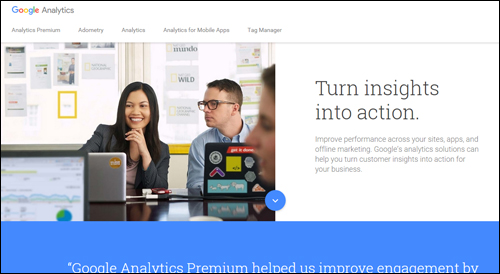
(Google Analytics)
Google Analytics lets you improve your site’s performance, SEO, user engagement, marketing efforts, and more, by tracking all user engagement, pages visited, keywords searched for, search engine referrals, etc.
After setting up your account, traffic monitoring information can be easily integrated with WordPress via plugins used with other applications and reporting tools.
Bing Data And Tools

(Bing Webmaster Tools)
Bing Webmaster Tools is similar to Google Search Console. Once your Bing Webmaster Tools account and site details have been set up, this information can be used to automate traffic-related settings and notifications in WordPress and other applications.
WordPress.com
(WordPress.com)
As explained in Part 2, WordPress provides users with a hosted (WordPress.com) and a self-hosted (WordPress.org) option. We recommended choosing the self-hosted WordPress version if you are planning to build a professional business presence online.
WordPress.com (the hosted option), however, provides some great tools, which can be accessed by various WordPress plugins. We recommend setting up an account at WordPress.com, therefore, and we’ll show you how to integrate these features into your web traffic system in the next installment of this series.
Social Media Accounts

(Syndicate your content automatically to your social media sites and social bookmarking accounts and attract new visitors to your site)
You will need your social media accounts set up before you can integrate these with your traffic generation system.
After setting up and configuring everything, you will be able to syndicate your content automatically to your social media sites and social bookmarking accounts and attract new visitors to your site.
You should have pages set up with all of the leading social networks – Facebook, Twitter, Pinterest, LinkedIn, YouTube, etc.

There are lots of social sites you can post your content to. You don’t need to create accounts with all of them, just choose the ones that will work well with your setup and/or content sharing tools.
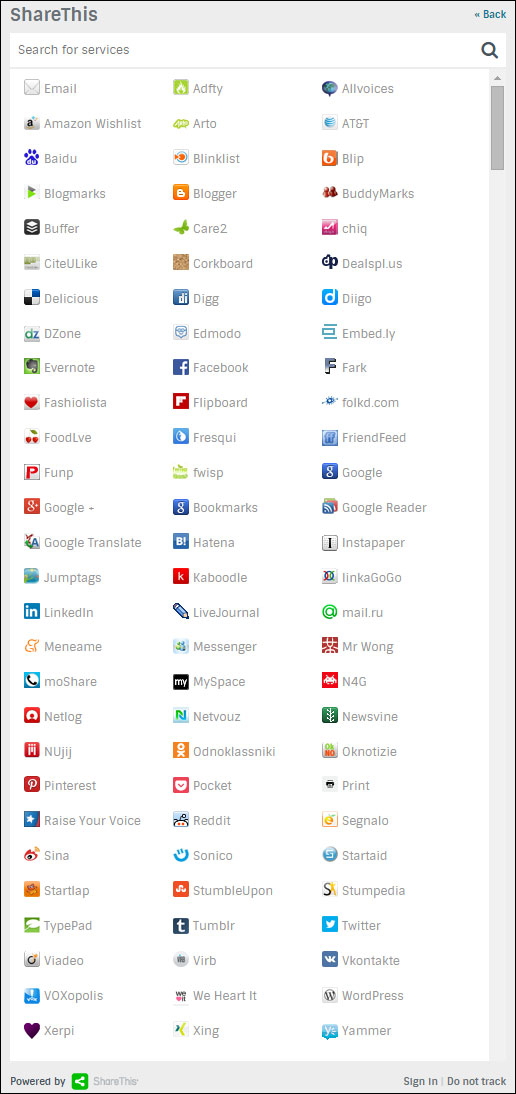
(You can post your content to lots of social sites. Image source ShareThis.com)
Additional Solutions, Content Aggregators, Etc.
There are many new online technology platforms and RSS aggregators that can act as secondary traffic generation sources. Some are free or provide free access levels, and some offer a range of pricing plans to suit different users.
For example, here is a content aggregator that lets you add your WordPress blog feed …
RebelMouse
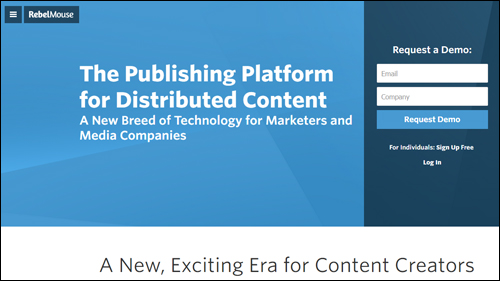
(RebelMouse)
RebelMouse is an aggregator for your RSS feeds and social profiles. Your content displays in a Pinterest-like format and users can follow your social feed.
![]()
There are many different solutions you can add to your traffic blueprint. Please feel free to contact us if you need assistance exploring some of these further, or to discuss a strategy to suit your needs.
After you have configured your web server and set up external site accounts, it’s time to configure your site’s settings.
Configuring WordPress
The first step in configuring your site for traffic is to ensure that your global settings have been correctly set up.
Let’s go over some key areas.
WordPress Settings
The WordPress administration area contains a Settings section that allows you to modify your site’s global settings …

(WordPress menu – Settings)
General Settings
Fields like Site Title and Tagline can influence your site’s SEO, search indexing, etc …
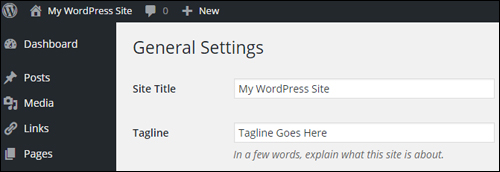
(Settings Menu – General Settings Screen)
Writing Settings
The Writing Settings section contains one of the most important and often overlooked traffic notification systems available to WordPress site owners …
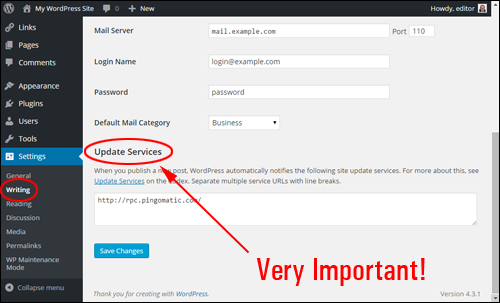
(Global Settings – Writing Settings)
As stated in this section,
When you publish a new post, WordPress automatically notifies the following site update services …
Unless you or your webmaster have purposely chosen to prevent search engines from indexing your site – see next section, then your site will automatically notify the update services entered into the Update Services text area
By default, when WordPress is installed, only one service is available …

(Update Services – A Powerful Traffic Feature)
WordPress lets you notify dozens of update services automatically – just add a list containing all of the update services you want notified to this section and WordPress will do the rest …
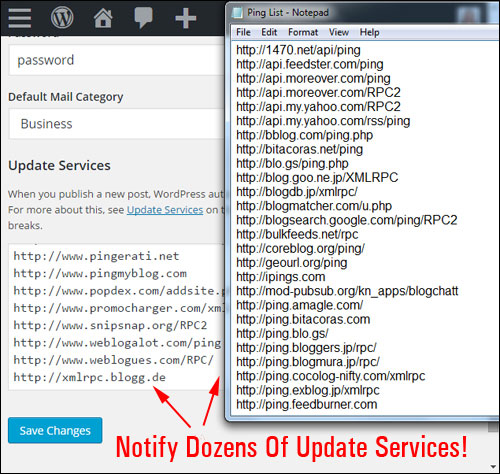
(WordPress lets you notify dozens of update services automatically!)
![]()
Download A Comprehensive List Of Ping Services For Your WordPress Site!
Click the link below to download a comprehensive list of reliable and authoritative ping services for your WordPress site or blog:
Download A List Of Ping Services For Your WordPress Site
***
Note: If you need help setting up the list of ping services on your site, we recommend using a professional web services provider. You can find professional WordPress service providers in our WordPress Services Directory.
Reading Settings
This section affects how your content gets seen by readers when they visit your home page and blog pages.
The syndication settings on this page can have an influence web traffic. For example, your choice of displaying the full text vs summaries of your post, affects how your content shows up in RSS readers and RSS email campaigns, and could impact someone’s choice to explore your site further, and whether or not they will visit your site to read the rest of the content from a partial feed, or read the content in full without the need to click through to your site.
The most important setting in this section as far as traffic is concerned is whether the Search Engine Visibility checkbox is enabled or not.
Generally, you want to encourage search engines to visit your site. Leaving this box unchecked allows your site to instantly ping various update services when a new post is published (see Writing Settings above). Unless there is a specific reason to discourage search indexing spiders from visiting your site, make sure this box is left unchecked …
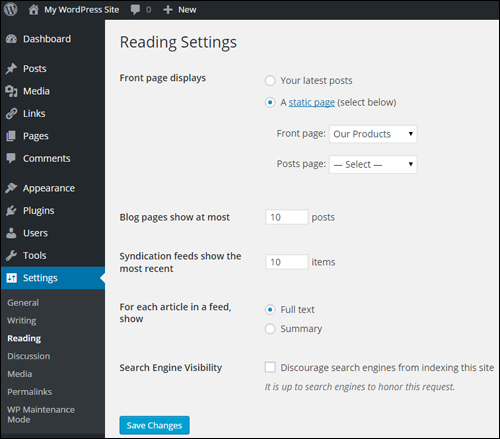
(Global Settings – Reading Settings Screen)
Discussion Settings
Although discussion settings are mostly concerned with how users engage with content on your site, you have the option to allow notifications to sites linked to from your posts, and to allow link notifications from other blogs (pingbacks and trackbacks). This can work for you, but it can also drive bad traffic in the form of SPAM comments …

(Global Settings – Discussion Settings)
Permalink Settings
Permalinks allow you to create SEO-friendly URLs …
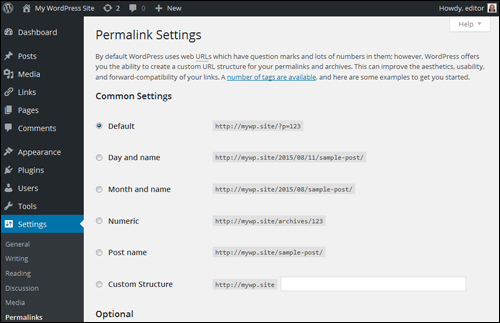
(WordPress Settings – Permalinks Screen)
Here are some of the options for configuring your site’s post permalinks …
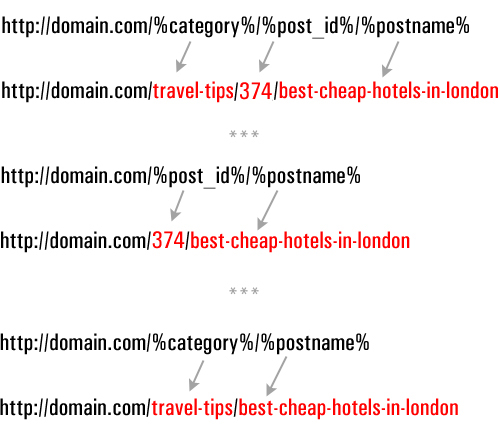
(Configuring post permalinks)
We have created a detailed tutorial on using WordPress permalinks here: Using Permalinks To Improve Your WordPress SEO
WordPress Traffic Plugin Settings – Configuration
WordPress provides users with plugins that can add just about every type of functionality to your website, including plugins with features that help to improve traffic generation.
Let’s take a brief look at some types of plugin categories that affect traffic and plugin examples
Blog Defender WordPress Security Plugin
Once again, it’s important to configure your website for dealing with both good traffic and bad traffic. Regardless of the kind of business you run or plan to run online and how small you think your web presence is, securing your websites is something you simply cannot afford to ignore.
 (WordPress Security Plugins help prevent bad traffic from harming your web presence)
(WordPress Security Plugins help prevent bad traffic from harming your web presence)
Security plugins like Blog Defender help to make your website invisible to attacks from hackers and bots.
For more information, go here:
WordPress SEO Plugins – Yoast SEO
SEO plugins help drive more traffic by improving your website’s SEO …

(WordPress SEO plugins like Yoast SEO help increase traffic by improving your website’s SEO)
A plugin like Yoast SEO can significantly improve your website’s search engine optimization. Once properly configured, this plugin not only makes your site easier for search engines like Google and Bing to find, crawl and index, it allows you to specify how your content will show up in Google’s search results and social media pages, e.g. Facebook, Twitter, and GooglePlus.
Social Plugins
Allowing your visitors to easily share your content with members of their social communities can help boost traffic to your site, especially if your site provides great content that adds real value to readers.

(WordPress users can easily add social sharing buttons to their site with free or inexpensive WordPress plugins)
You can add social sharing to your site easily with WordPress plugins.
Many social plugins allow you to choose which sites your content can be shared to, embed social buttons into your content, set up default update notifications, display/hide share counters (e.g. number of likes), etc. Some social plugins even allow you to set up protected content sections on your site which users can unlock by liking your page.
Theme Settings
As well as configuring various plugins, many WordPress themes also include features that can help grow your traffic.
For example, as well as options and settings for configuring the design and layout of your site, some themes also provide built-in features that let you improve SEO and site linking structure for better indexing, add analytics, social sharing buttons, etc …

(Many themes include built-in traffic optimization features)
With a number of quality themes, adding social sharing features to your site is as easy as selecting the option to enable this functions …

(Many WordPress themes have built-in social sharing features that can be easily enabled on with the click of a button)
Additional Areas To Configure
Last (but by no means least) in the traffic configuration process, are the areas that need to be set up outside of the global settings.
This includes the following:
Legal Web Pages
Once again, when preparing your site for an increase in traffic, it’s important to plan not only for both good and bad traffic but also for all the things that can go wrong as more and more people find and begin to visit your website.
If you do business online (or are planning to), it’s important that your website complies with legal requirements of government agencies that regulate how business online is done.
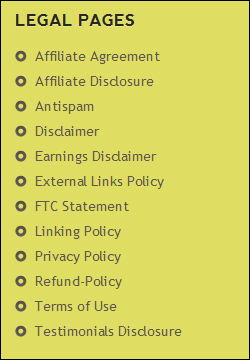 (Is Your Website Legally Compliant?)
(Is Your Website Legally Compliant?)
For a detailed article about how to quickly and easily add legal pages to your website or blog, go here:
Post Tags And Categories
Tags and categories help improve traffic by improving your site’s search optimization.
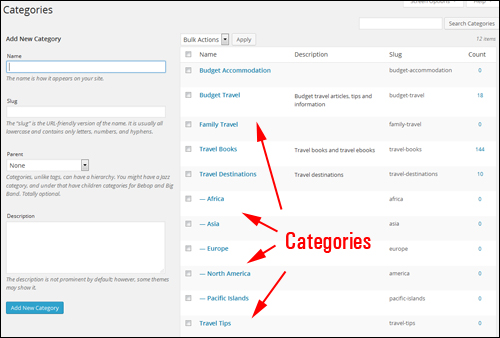
(Categories help search engines classify and index your website, which helps you get more traffic.)
As we recommend in this article, it’s best to review and set up your website’s post categories and tags earlier on, during the Website Planning Process.
In the configuration phase, you will want to review and make sure that the post tags and post categories that have been set up.
A Site Map Of Your Posts And Pages
A visitor site map that displays all of your site’s posts and pages is not only a useful navigation tool for users, it can also help external tools discover your website content …

(Site Map – great for visitors and beneficial for traffic too!)
![]()
An HTML site map and an XML sitemap are different things. Although Google can index your site just from an XML sitemap (which a plugin like Yoast SEO will create for you – see earlier section), allowing visitors to find more pages on your site can result in increased traffic.
404 Page Not Found – Don’t Forget To Configure This Too!
When visitors searching for your website enter the wrong web address or click on a dead hyperlink, they will typically be presented with a 404 Not Found error page …

(A 404 Page)
A 404 Not Found page can be configured to funnel traffic to your functional web pages …
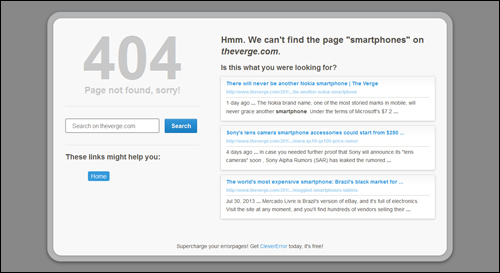
(Configuring your 404 page allows you to redirect traffic that may otherwise be lost.)
![]()
Although a 404 page can be set up on your server, there are WordPress plugins that let you easily configure your 404 page from your WordPress admin.
WordPress Traffic Blueprint: Configuration Stage – Summary
Once you have your website or blog expertly configured and fully set up, all you have to do then is publish fresh content regularly to attract more web traffic organically.
The process of expertly configuring your WordPress site, however, is quite involved and elaborate , requiring the configuration and integration of various components and web properties …
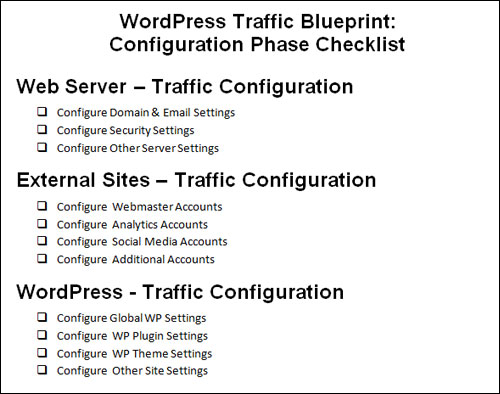
(WordPress Traffic Blueprint – Configuration Phase Checklist)
![]()
The kind of expertise required to perform the configuration process can take some web professionals months to learn.
Once you have expertly configured your WordPress site, the next step is to automate the aspects of the process that can be automated. This step is covered in the next article in our series.
This is the end of Section 3
To read the rest of this article, click on the link below:

![]()
This tutorial is part of an article series designed to help you learn how to grow your business online cost-effectively using a WordPress website and proven online marketing strategies.
Want To Get Automatically Notified When New Tutorials Are Published? Then Subscribe Using The Form Below!
***
"I am beyond impressed with what you have put together. I can tell that you put a ton of hard work into building what you have. You have the absolute best content on WordPress I have ever seen!" - Robert T. Jillie
***
